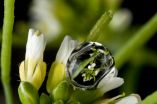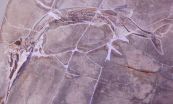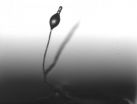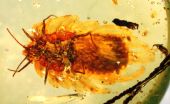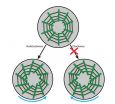Rodeo in liquid crystal
Scientists have achieved an unprecedented level of control over defects in liquid crystals that can be engineered for applications in liquid matter photonics
2015-03-31
(Press-News.org) Sitting with a joystick in the comfort of their chairs, scientists can play "rodeo" on a screen magnifying what is happening under their microscope. They rely on optical tweezers to manipulate an intangible ring created out of liquid crystal defects capable of attaching a microsphere to a long thin fibre. Maryam Nikkhou and colleagues from the Jožef Stefan Institute, in Ljubljana, Slovenia, recently published in EPJ E the results of work performed under the supervision of Igor Muševič. They believe that their findings could ultimately open the door to controlling the flow of light using light of a specific frequency in the Gigahertz range in liquid crystal photonic microdevices.
Liquid crystals are familiar to us from their application in LCD screens. What makes them so interesting is that they are rich in defects. Thanks to advances in manipulation tools such as optical tweezers, the authors were able to create an arbitrary number of defect pairs on a long thin fibre plunged into a nematic liquid crystal - an ordered fluid with long organic molecules all pointing in the same direction like sardines in a tin.
Nikkhou and colleagues use very strong laser tweezers to locally melt the liquid crystal into a phase where the molecules are oriented in all directions, encircling one part of the fibre. They subsequently switch-off the laser light, resulting in the locally molten liquid crystal rapidly cooling down. Its molecules then revert back from being oriented in all directions to being parallel to each other, creating several pairs of defects - akin to localised disruptions of the crystal's ordering field - forming a ring. Because liquid crystals are made of soft materials, their defects can be moved and modified easily. The defect ring is used as a non-material "rope" to entangle and strongly bind a microsphere and long fibre of micrometric diameter. Because these defects are typically preserved when subjected to stretching and bending, they offer an ideal physical model of an abstract field of mathematics called topology.
INFORMATION:
Watch the video from the article:
https://www.youtube.com/watch?v=3JpZhObcYuI
Reference: Topological binding and elastic interactions of microspheres and fibres in a nematic liquid crystal. M. Nikkhou, M. Škarabot, and I. Muševi? (2015), Eur. Phys. J. E 38: 23, DOI 10.1140/epje/i2015-15023-6
www.twitter.com/SpringerSBM END
ELSE PRESS RELEASES FROM THIS DATE:
2015-03-31
The Internet brings the world to our fingertips, but it turns out that getting information online also has a startling effect on our brains: We feel a lot smarter than we really are, according to a Yale-led study published March 30 in the Journal of Experimental Psychology.
In nine different experiments with more than 1,000 participants, Yale psychologists found that if subjects received information through Internet searches, they rated their knowledge base as much greater than those who obtained the information through other methods.
"This was a very robust effect, ...
2015-03-31
WASHINGTON - Searching the Internet for information may make people feel smarter than they actually are, according to new research published by the American Psychological Association.
"The Internet is such a powerful environment, where you can enter any question, and you basically have access to the world's knowledge at your fingertips," said lead researcher Matthew Fisher, a fourth-year doctoral candidate in psychology at Yale University. "It becomes easier to confuse your own knowledge with this external source. When people are truly on their own, they may be wildly ...
2015-03-31
PHILADELPHIA - HIV (human immunodeficiency virus)-positive kidney transplant patients experienced superior outcomes when compared to kidney transplant patients with Hepatitis C and those infected with both HIV and Hepatitis C, according to a study led by researchers at the Perelman School of Medicine at the University of Pennsylvania and published online in Kidney International.
The research team examined outcomes of 124,035 adult kidney recipients transplanted between 1996 and 2013, and found the three-year survival rate of HIV patients (89 percent) was actually very ...
2015-03-31
Inhalable particles include all particulate matter with a diameter smaller than 10 micrometers (PM10). In this group a distinction is made between even finer particles smaller than 2.5 micrometers (PM2.5) in diameter, which can deeply enter the lung, and ultrafine particles with diameters less than 0.1 micrometers (100 nanometers), which can also enter the blood stream.
The research team at Helmholtz Zentrum München led by Prof. Dr. Annette Peters, head of the research program Epidemiology at the German Center for Diabetes Research (DZD), and Dr. Alexandra Schneider ...
2015-03-31
Scientists at the John Innes Centre have discovered why the first buds of spring come increasingly earlier as the climate changes.
Dr Steven Penfield at the JIC found that plants have an ideal temperature for seed set and flower at a particular time of year to make sure their seed develops just as the weather has warmed to this 'sweet spot' temperature.
Dr Penfield, working with Dr Vicki Springthorpe at the University of York, found the sweet spot for the model plant Arabidposis thaliana is between 14-15?C. Seeds that develop in temperatures lower than 14?C will almost ...
2015-03-31
Saurichthys is a predatory fish characterized by a long thin body and a sharply pointed snout with numerous teeth. This distinctive ray-finned fish lived in marine and freshwater environments all over the world 252-201 million years ago during the Triassic period. Two new species of this extinct fish have been discovered by paleontologists at the University of Zurich, working in collaboration with researchers in Germany and China. The first species, «Saurichthys breviabdominalis», is named for its relatively short body and the second, «Saurichthys rieppeli», ...
2015-03-31
Darwin's evolutionary theory predicts survival of the fittest. So why do different survival tactics co-exist, if evolution should always favour the winning strategy?
To answer that question scientists at the Universities of Bath and Manchester have been studying a single-celled amoeba, also known as slime mould, which displays certain behaviours that have been labelled as "cheating" or "cooperating".
In a study, published in the prestigious journal Current Biology, the team found that cheaters don't necessarily win in terms of overall survival, suggesting that biologists ...
2015-03-31
Scientists at the University of Bonn, together with colleagues from China, UK and Poland, have described the oldest evidence of brood care in insects: it is in a female scale insect with her young that is encased in amber as a fossil. The approximately100-million-year-old "snapshot" from the Earth's history shows the six millimetre long tiny insect with a wax cocoon, which protected the eggs from predators and drying out plus associated young nymphs. The researchers are now presenting their results in the respected journal eLIFE.
The small female insect with the waxy ...
2015-03-31
Face recognition security on smartphones can be significantly improved if users store an 'average' photo of themselves, according to new research by scientists at the University of York.
A research team led by Dr David Robertson, of the Department of Psychology's FaceVar laboratory at York, found that combining different pictures of the user, rather than a single 'target' image, leads to much better recognition across all kinds of daily settings. The research is published in the journal PLOS ONE.
The researchers examined the performance of the 'face unlock' system ...
2015-03-31
Researchers at the Mechanobiology Institute (MBI) at the National University of Singapore have discovered that the inherent 'handedness' of molecular structures directs the behaviour of individual cells and confers them the ability to sense the difference between left and right. This is a significant step forward in the understanding of cellular biology. This discovery was published in Nature Cell Biology on 23 March 2015.
Cellular decision making
Our bodies are made up of hundreds of different types of cells, each of which performs a unique and highly specialized ...
LAST 30 PRESS RELEASES:
[Press-News.org] Rodeo in liquid crystal
Scientists have achieved an unprecedented level of control over defects in liquid crystals that can be engineered for applications in liquid matter photonics
